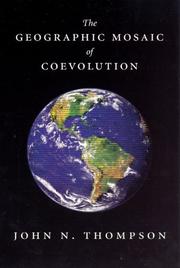| Listing 1 - 10 of 13 | << page >> |
Sort by
|

ISBN: 0226797627 0226797619 1299730736 022611869X 9780226118697 9780226797618 9780226797625 Year: 2005 Publisher: Chicago University of Chicago Press
Abstract | Keywords | Export | Availability | Bookmark
 Loading...
Loading...Choose an application
- Reference Manager
- EndNote
- RefWorks (Direct export to RefWorks)
Coevolution-reciprocal evolutionary change in interacting species driven by natural selection-is one of the most important ecological and genetic processes organizing the earth's biodiversity: most plants and animals require coevolved interactions with other species to survive and reproduce. The Geographic Mosaic of Coevolution analyzes how the biology of species provides the raw material for long-term coevolution, evaluates how local coadaptation forms the basic module of coevolutionary change, and explores how the coevolutionary process reshapes locally coevolving interactions across the earth's constantly changing landscapes. Picking up where his influential The Coevolutionary Process left off, John N. Thompsonsynthesizes the state of a rapidly developing science that integrates approaches from evolutionary ecology, population genetics, phylogeography, systematics, evolutionary biochemistry and physiology, and molecular biology. Using models, data, and hypotheses to develop a complete conceptual framework, Thompson also draws on examples from a wide range of taxa and environments, illustrating the expanding breadth and depth of research in coevolutionary biology.
Evolution. Phylogeny --- Coevolution. --- Biology. --- Genetics. --- Biology --- Health & Biological Sciences --- Evolution --- Evolution (Biology) --- Co-evolution --- Animal evolution --- Animals --- Biological evolution --- Darwinism --- Evolutionary biology --- Evolutionary science --- Origin of species --- Biological fitness --- Homoplasy --- Natural selection --- Phylogeny --- ecology, evolution, evolutionary, biology, biological, ecological, science, scientists, coevolution, change, species, natural selection, biodiversity, interactions, survival, reproduction, adaptation, coadaptation, genetics, phylogeography, systematics, biochemistry, physiology, populations, dynamics, displacement, convergence.

ISBN: 0226797600 0226797597 9780226797670 0226797678 9780226797595 9780226797601 128253730X 9781282537309 9786612537301 6612537302 Year: 1994 Publisher: Chicago University of Chicago Press
Abstract | Keywords | Export | Availability | Bookmark
 Loading...
Loading...Choose an application
- Reference Manager
- EndNote
- RefWorks (Direct export to RefWorks)
Traditional ecological approaches to species evolution have frequently studied too few species, relatively small areas, and relatively short time spans. In 'The Coevolutionary Process,' John N. Thompson advances a new conceptual approach to the evolution of species interactions--the geographic mosaic theory of coevolution. Thompson demonstrates how an integrated study of life histories, genetics, and the geographic structure of populations yields a broader understanding of coevolution, or the development of reciprocal adaptations and specializations in interdependent species. Using examples of species interactions from an enormous range of taxa, Thompson examines how and when extreme specialization evolves in interdependent species and how geographic differences in specialization, adaptation, and the outcomes of interactions shape coevolution. Through the geographic mosaic theory, Thompson bridges the gap between the study of specialization and coevolution in local communities and the study of broader patterns seen in comparisons of the phylogenies of interacting species.
Co-evolution --- Coevolution --- Coévolution --- Coëvolutie --- Insect-plant relaties --- Insect-plant relationships --- Insecte-plante [Relations ] --- Insecten en planten --- Insectes et plantes --- Insects and plants --- Plant-insect relationships --- Plante-insecte [Relations ] --- Planten en insecten --- Plantes et insectes --- Plants and insects --- Relations insecte-plante --- Coevolution. --- Insect-plant relationships. --- Coévolution
Article
Abstract | Keywords | Export | Availability | Bookmark
 Loading...
Loading...Choose an application
- Reference Manager
- EndNote
- RefWorks (Direct export to RefWorks)
Book
ISBN: 9780226018614 9780226018751 Year: 2013 Publisher: Chicago, Ill. The University of Chicago Press
Abstract | Keywords | Export | Availability | Bookmark
 Loading...
Loading...Choose an application
- Reference Manager
- EndNote
- RefWorks (Direct export to RefWorks)
Book
ISBN: 0471090220 Year: 1982 Publisher: New York : Wiley,
Abstract | Keywords | Export | Availability | Bookmark
 Loading...
Loading...Choose an application
- Reference Manager
- EndNote
- RefWorks (Direct export to RefWorks)
Evolution --- Coevolution --- Coévolution
Book
Year: 1992 Publisher: Washington (D.C.): Smithsonian institution press
Abstract | Keywords | Export | Availability | Bookmark
 Loading...
Loading...Choose an application
- Reference Manager
- EndNote
- RefWorks (Direct export to RefWorks)
Book
Year: 1992 Publisher: Washington Smithsonian Institution Press
Abstract | Keywords | Export | Availability | Bookmark
 Loading...
Loading...Choose an application
- Reference Manager
- EndNote
- RefWorks (Direct export to RefWorks)
Book
Year: 1992 Publisher: Washington, DC : Smithsonian Institution Press,
Abstract | Keywords | Export | Availability | Bookmark
 Loading...
Loading...Choose an application
- Reference Manager
- EndNote
- RefWorks (Direct export to RefWorks)
Book

Year: 2001 Publisher: S.l. cop. Annual Reviews
Abstract | Keywords | Export | Availability | Bookmark
 Loading...
Loading...Choose an application
- Reference Manager
- EndNote
- RefWorks (Direct export to RefWorks)
Book

ISBN: 9781400837090 Year: 2022 Publisher: Princeton, NJ
Abstract | Keywords | Export | Availability | Bookmark
 Loading...
Loading...Choose an application
- Reference Manager
- EndNote
- RefWorks (Direct export to RefWorks)
| Listing 1 - 10 of 13 | << page >> |
Sort by
|

 Search
Search Feedback
Feedback About UniCat
About UniCat  Help
Help News
News